Volleyball drills for technique attack / smash / spike / hitting
- Rebounding (per 2): wrist hit, correct foot forward, weaponing, hit the ball
- Kids bump with the ball on the ground to control afterwards and then hit the ball.
- FIRST (individually): hit downwards (wrist hit, correct foot forward, weaponing)
- THEN (individually): hit with wrist hit over the net
- THEN (per 2): hit with wrist hit over the net. The other kid defends this ball and hits back
- LAST (per 2): but then on points
- Per 2, each on one side of the field + a ball. Steps of attack run and then hit underneath the net ( 1 hand points to the ball, the other hand hits, wrist clamps around ball) other catches and does the same.
Attack on outside on two fields. Players pay attention to their run and arms. Then attack on the middle.
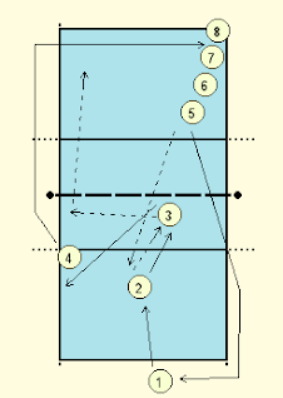
Player 1 is behind the end line and is reserve. Player 2 is in the middle of the field. Player 3 is on position 2-3. Player 4 is attacker left forward. Players 5-8 are in the other field left forward, all with a ball.
The first of the line (player 5 in this case) throws the ball to the middle of the other field. After throwing, he walks to the end line of the other field .
- Player 3 passes the ball to player 3 and follows his ball.
- Player 3 gives a set up to left forward position.
- Player 4 smashes the ball over the net, picks up the ball and join the back of the line.
- And it starts at the beginning. The next ball can be thrown when the set up has been given.
You have to score!
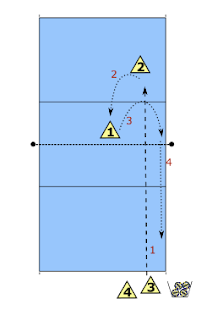
- For this exercise, the field is divided in two lengthwise
- Four persons on one side, four on the other side.
- 3 and 4 (1) serve.
- Player 2 passes the ball (2),
- player 1 gives a set up (3) and
- player 2 smashed the ball straight (4) so not diagonally.
- If 1 and 2 score together, they change spots, so 2 will be playmaker, and player 1 is going to pass and attack.
- if 1 and 3 DO NOT score, the attacker is going to serve, the playmaker is going to attack, and the server is going to be playmaker. The attacker is 'punished' because he did not score.
What is scoring here? Make clear agreements, for example a ball hit along the line.
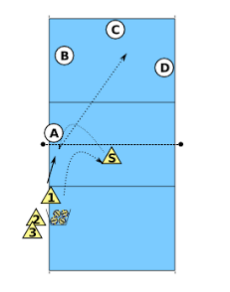
- this exercise, the attackers get the mission to immediately score with their attack. The defense has to prevent this of course.
A permanent playmaker is used. A number of attackers is on one side of the playing field with a ball. They play the ball to the playmaker, who will give the set up for the attacker.
If the attacker scores, he joins the back of the line of attackers (as reward). If the attacker does not score, he has to defend. Rotating happens in the following way. attacker - A - B - C - D - attacker.
In defense, A is the blocker.
Make it clear upfront what immediate scoring means: ball on the ground, even if there is no playable defense. - permanent playmaker
- line of attackers with ball plays ball to sv
- Set-up to attacker 1
- If attack scores, join line attackers
- Otherwise attacker 1 to A - B - C- D- attacker
- In defense: A = blocker, BCD= back
- 1 serve, pass to S
- S sets up at 3 meters to one of the passers
- idem other side
- make rally
- serve from the side where the ball hits the ground
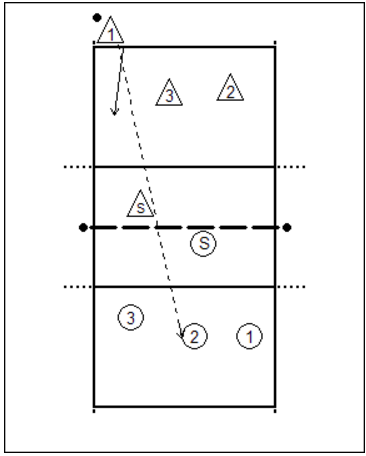
- bring the ball into the game; S sets up to left forward
- 1 diagonal attack
- all rotate one spot when ball is over the net
- defend diagonal attack on set-upper
- set up to left forward, attack diagonally; etc.
POINTS OF ATTENTION:
- when rotating, quickly to starting position
- all provide attack defense
- right forward block put straight
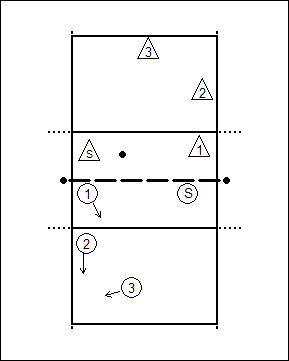
- A serves to B.
- B passes the ball to the playmaker, who then plays a high ball in the back field.
- B defends this ball back to the playmaker, which gives a set up for A.
- A attacks to this set up.
After the attack, A takes the place of B, and B will be reserve. The playmaker remains.
The outside attackers use one playmaker and the left side of the field. The centre attackers and the diagonal attackers use the right side with a different playmaker.
Expansion:
- After the service, A takes a second ball.
- After the attack of B, A throws this ball into the field.
- B plays this ball to the playmaker, the playmaker gives a set up
- B attacks again.
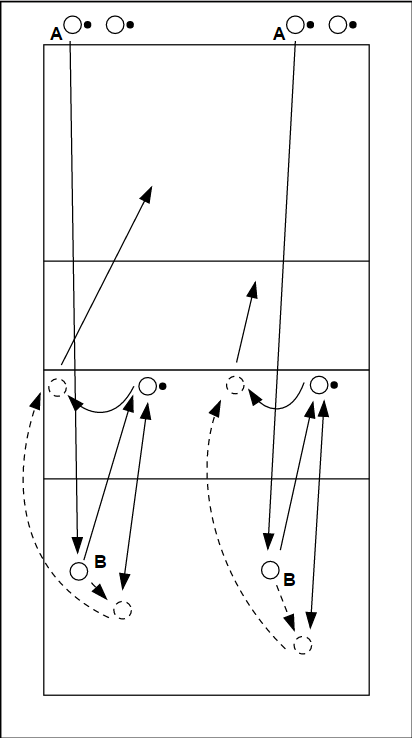

| If you put pressure on the opponent with your service and attack, the balls easily get over the net. It is a must to process these balls properly and (quickly) set up another attack. Precision is of the highest importance. The responsibilities have to be clear and taken by the players. It has to be clear for whom the easy ball is and who passes it. The place to which the ball is passed must also be clear. The speed of the rally pass is also of importance. Particularly when the playmaker is forward, you can pass the ball quicker to the net. Closer to the net, you pass the ball a bit higher, so everybody has time to prepare for the attack. The exercise: Coach throws ball in to the six. They build up an attack The six have to score from the rally pass. The four have to prevent this by blocking the ball and defend. When the 6 have 5 points, change. score keeping:
|
If volleyball players think they are starting the attack pass to soon, or the trainer thinks the attackers come in too soon, this is a good exercise.
The playmaker is positioned with a box of balls. He has to throw up the ball for himself 5 times or less. The attackers doe not know how often this happens, and can only leave when the set-up is done, not before.
The attackers will have to come in more aggressively, building up more speed and thus more height, if there is a good brake pass.
If this goes well, the trainer can decide to move the playmaker closer to the attackers, so the distance the set-upper has to cover is shortened. The attackers have to be even more alert.
- Everybody 1 ball, and hit the wall via the ground.
- Hit the ball so clamp wrist around the ball.
- Think about exit and raise both arms in the air.
- 3 to 4 players, 1 ball, entire field 3 to 4 players
- Lower net, and then match hitting ball over the net
- The other is trying to catch
- The ball can bounce 1 time and the other tries to catch (can also catch immediately)
- After catching, throw to other player and smash again
- If the ball is not caught, you have a point
- pairs with net in between and 1 ball
- Make last 2 steps of attack run (large step + connecting step)
- Throw ball up with both hands
- and hit ball underneath the net
- 1 hand points to the ball
- the other hand hits
- clamp wrist around ball
- The other catches the ball and does the same.







